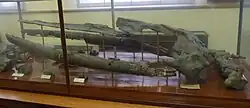| Cetotheriophanes Temporal range: | |
|---|---|
 | |
| Skull in Bologna | |
| Scientific classification | |
| Domain: | Eukaryota |
| Kingdom: | Animalia |
| Phylum: | Chordata |
| Class: | Mammalia |
| Order: | Artiodactyla |
| Infraorder: | Cetacea |
| Family: | Balaenopteridae Gray 1864 |
| Genus: | †Cetotheriophanes Brandt 1873 |
| Species | |
|
†C. capellinii (Brandt, 1873) (type) | |
Cetotheriophanes is an extinct rorqual from the late Pliocene (Piacenzian) of northern Italy.[1]
Classification
Cetotheriophanes was originally described as a subgenus of Cetotherium in 1873, but later elevated to full generic status in 1875. It was later considered a synonym of Balaenoptera by some authors, but recent work suggests that Cetotheriophanes is distinct from Balaenoptera.
References
- ↑ T. A. Demere, A. Berta, and M. R. McGowen. 2005. The taxonomic and evolutionary history of modern balaenopteroid mysticetes. Journal of Mammalian Evolution 12(1/2):99-143
Sources
- Brandt, J. F., von (1873). "Über bisher in Russland gefundene Reste von Zeuglodonten". Mélanges Biologiques Tirés du Bulletin de l'Académie Impériale des Sciences de St. Pétersbourg. 9: 192–193.
{{cite journal}}: CS1 maint: multiple names: authors list (link) - Gray, J. E. (1864). "Notes on the Whalebone-Whales; with a Synopsis of the Species". The Annals and Magazine of Natural History. 14 (83): 345–353. doi:10.1080/00222936408681724.
This article is issued from Wikipedia. The text is licensed under Creative Commons - Attribution - Sharealike. Additional terms may apply for the media files.